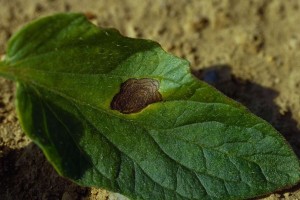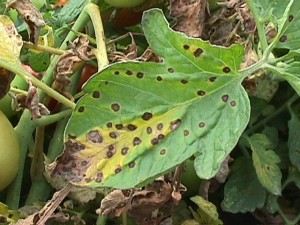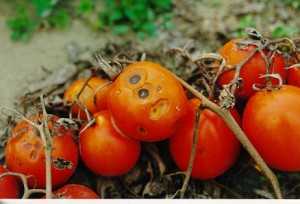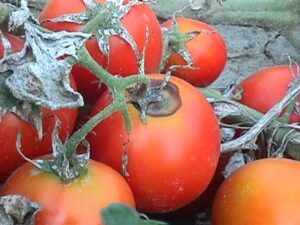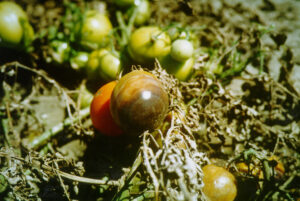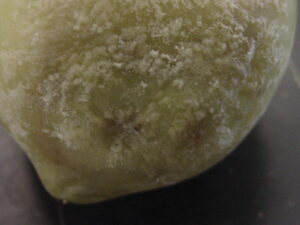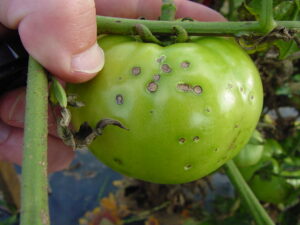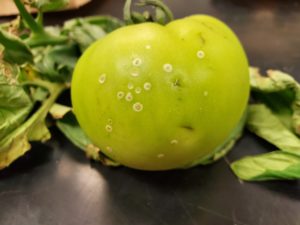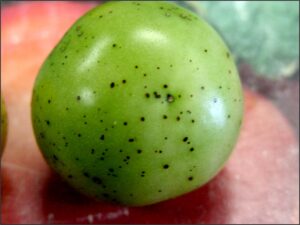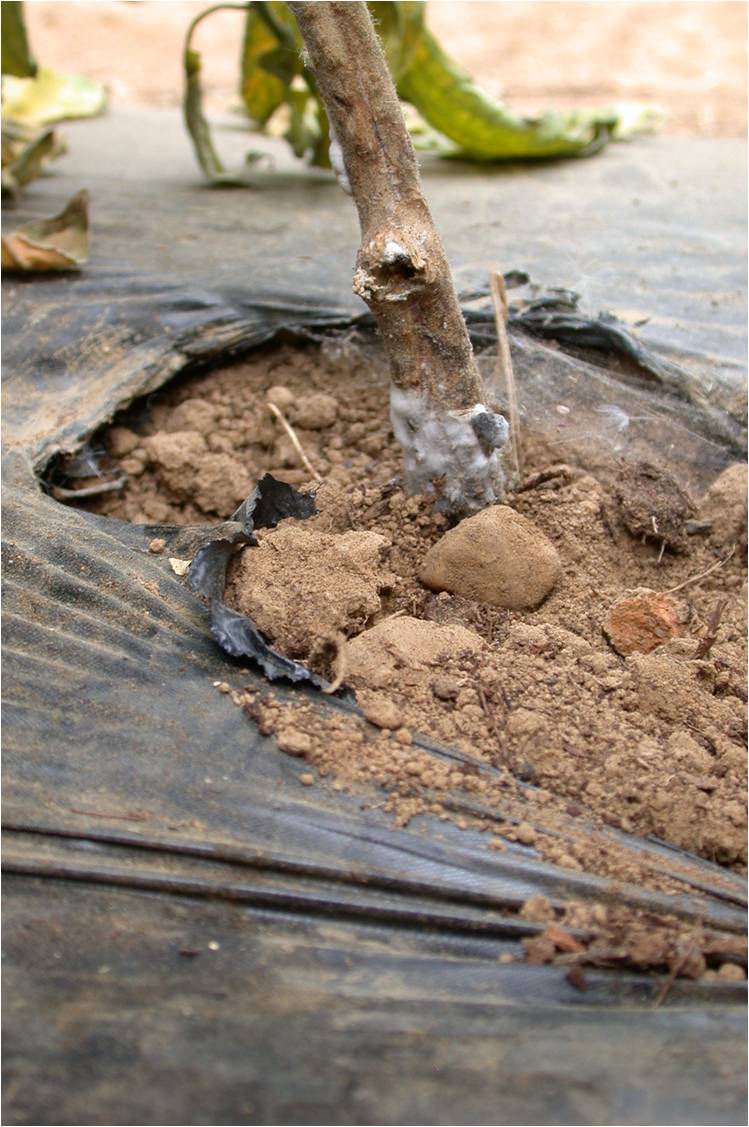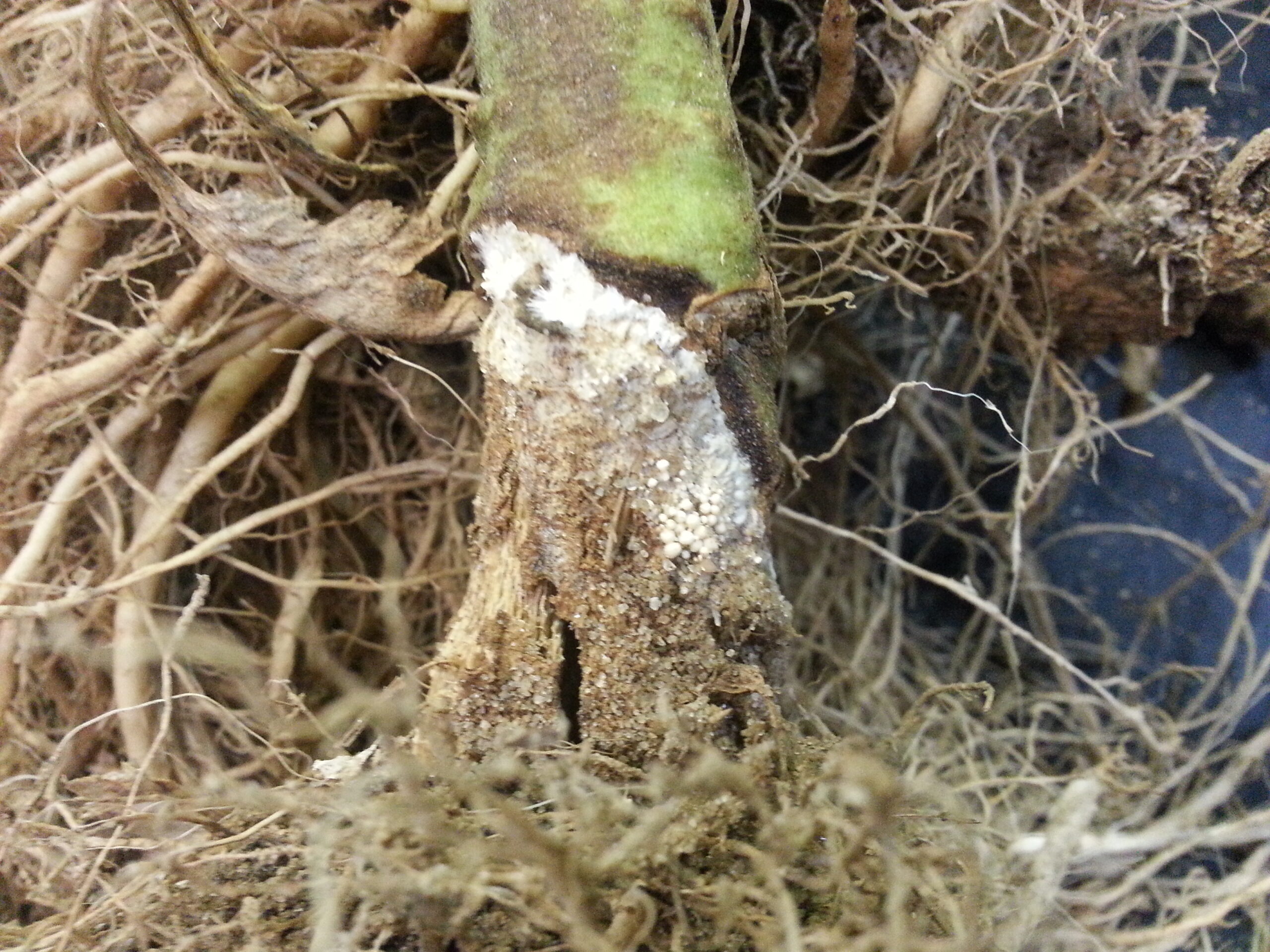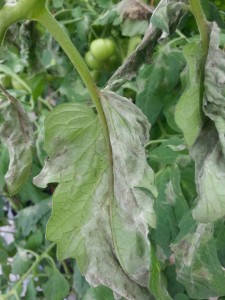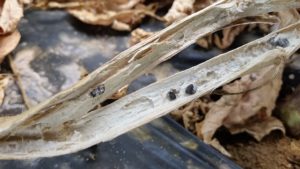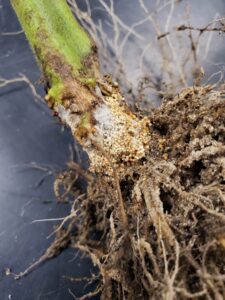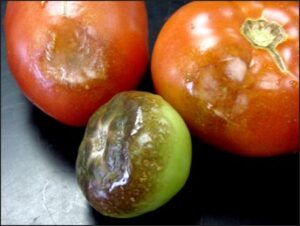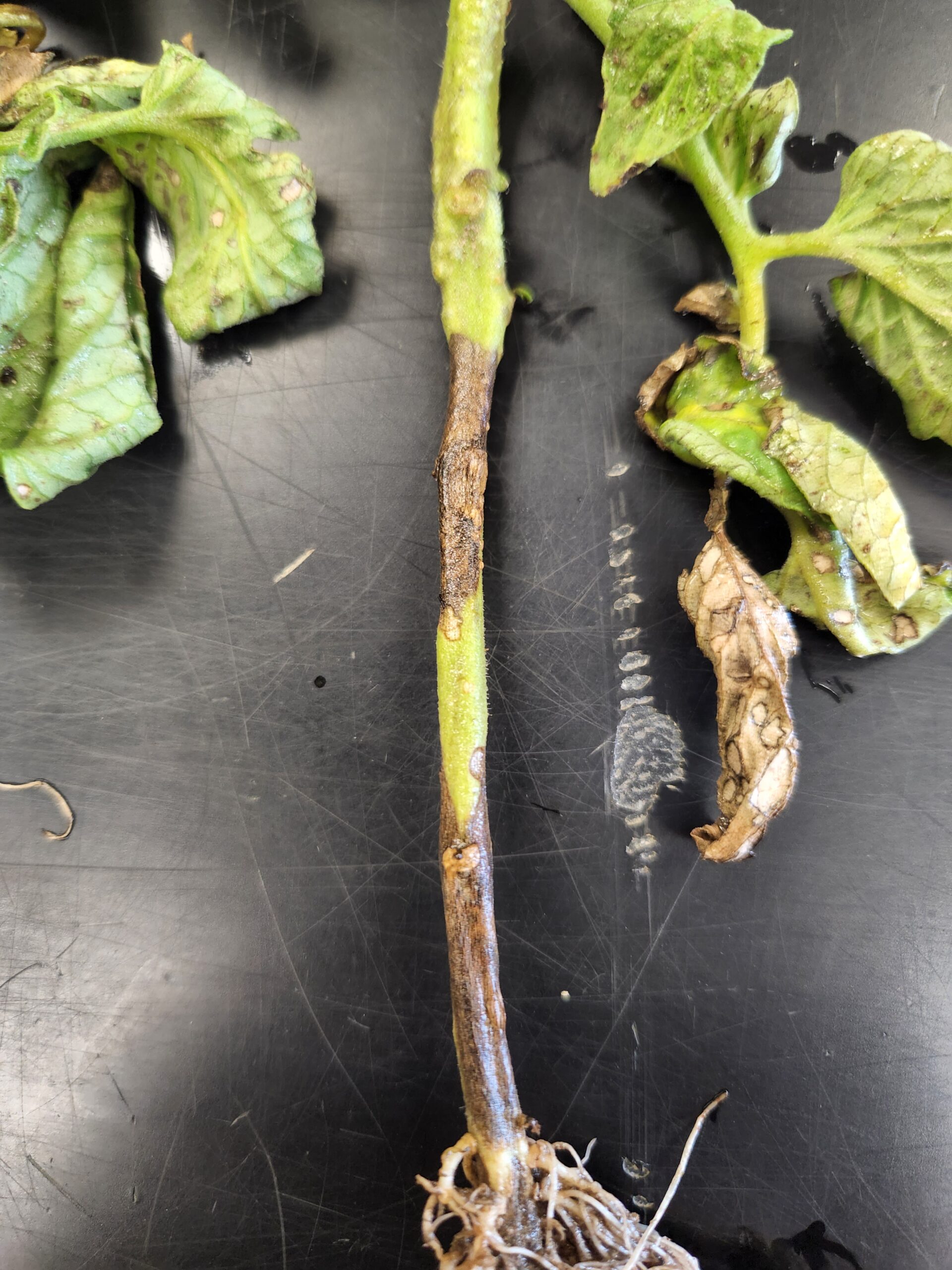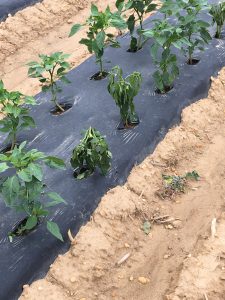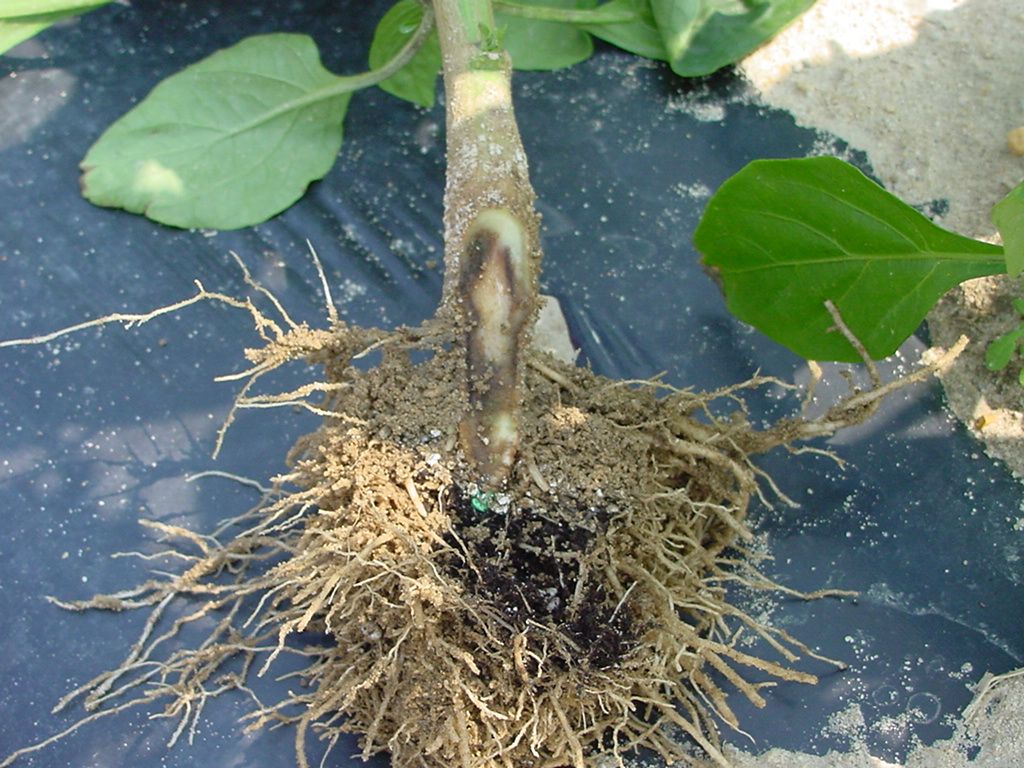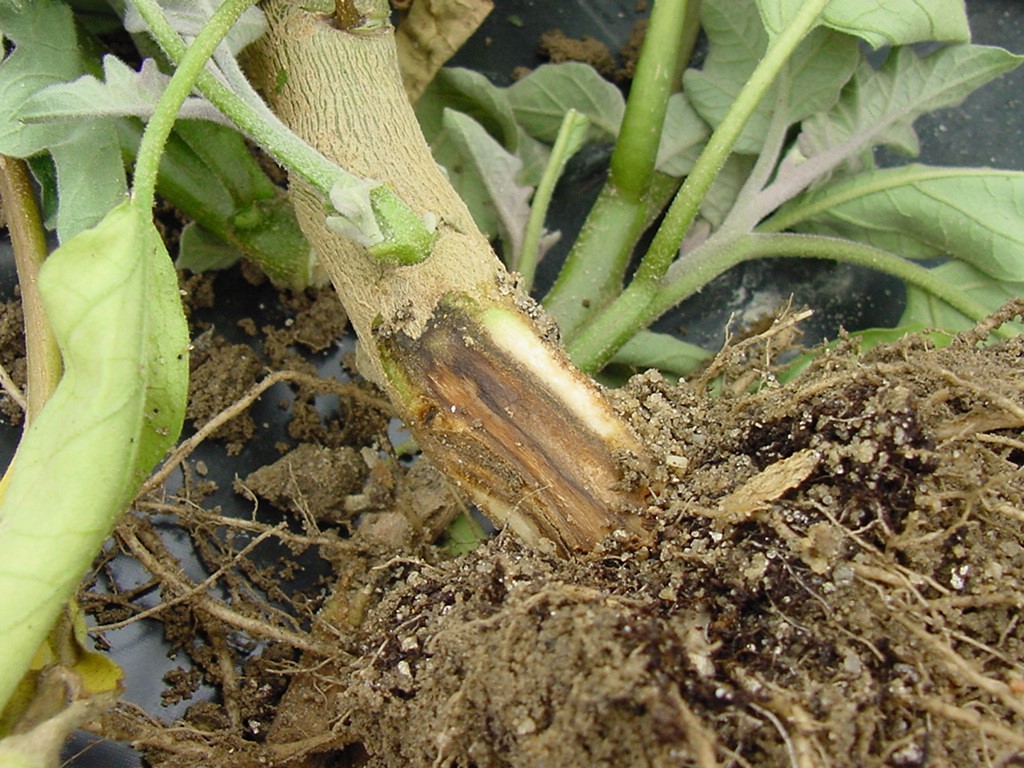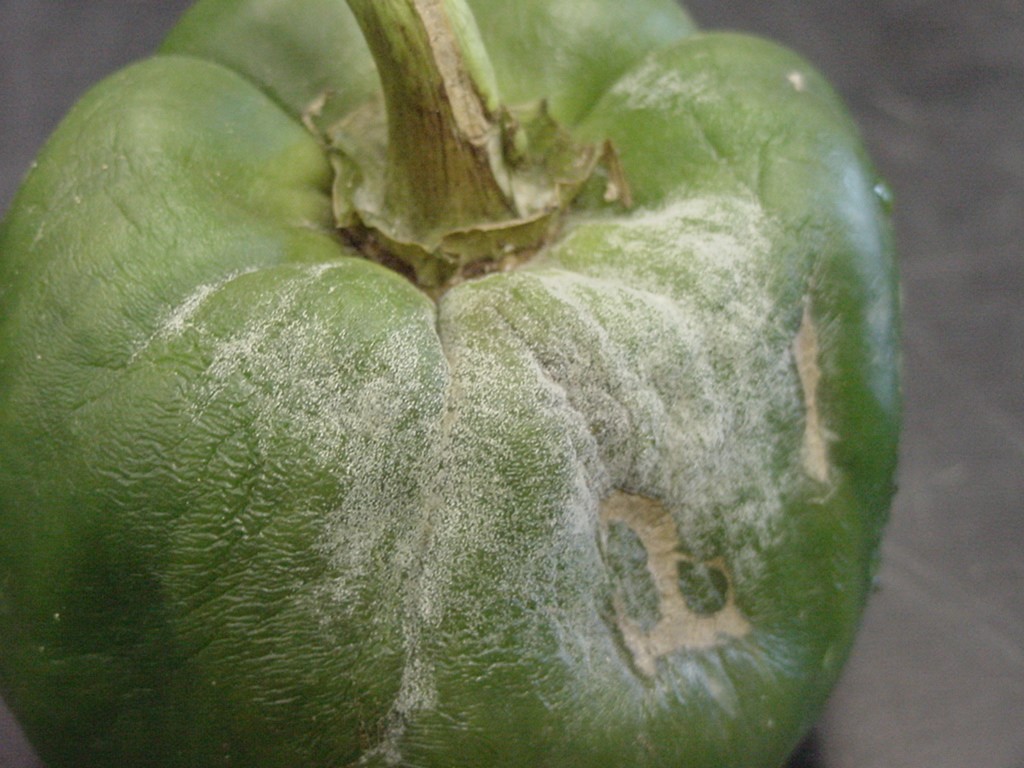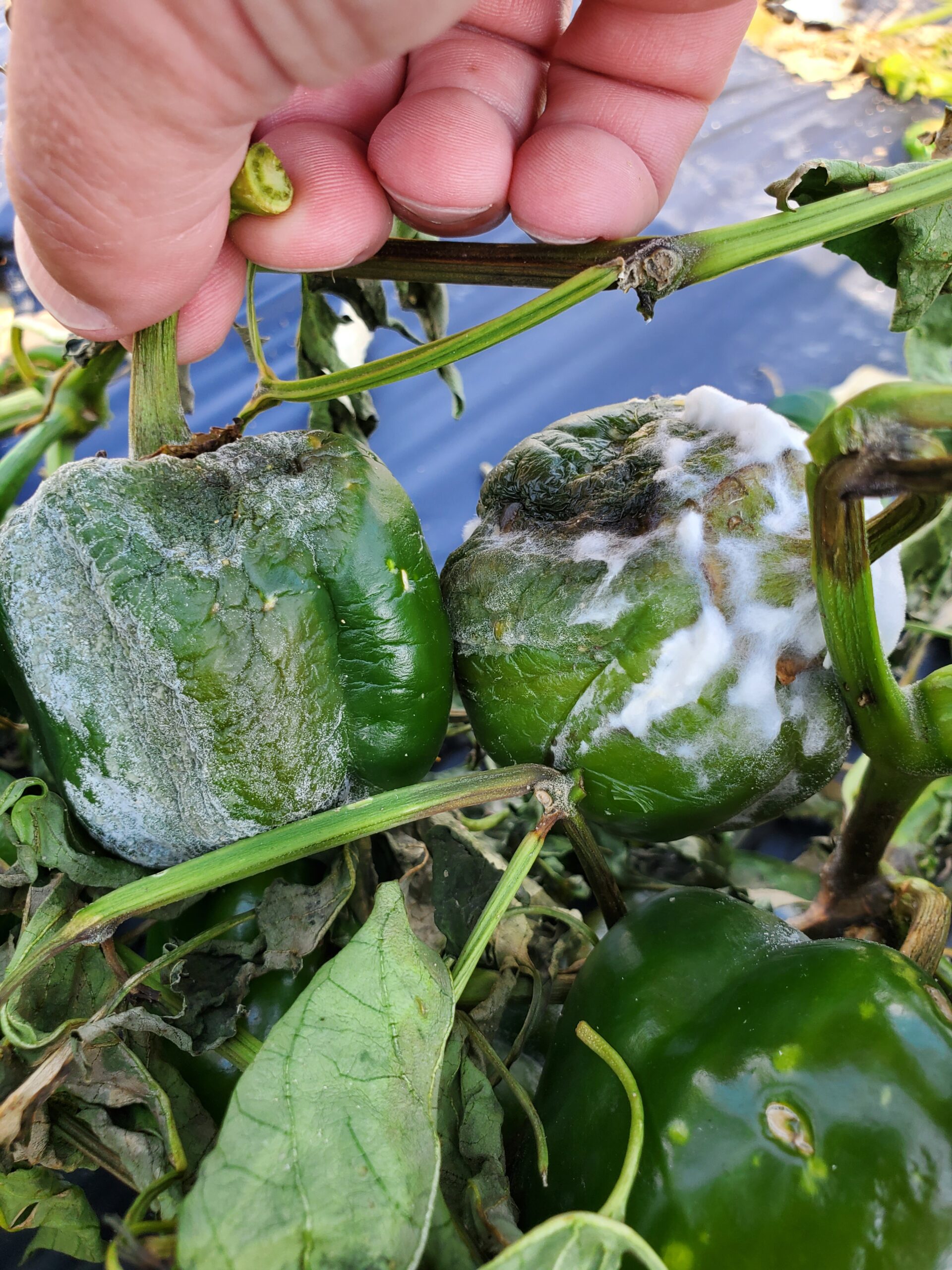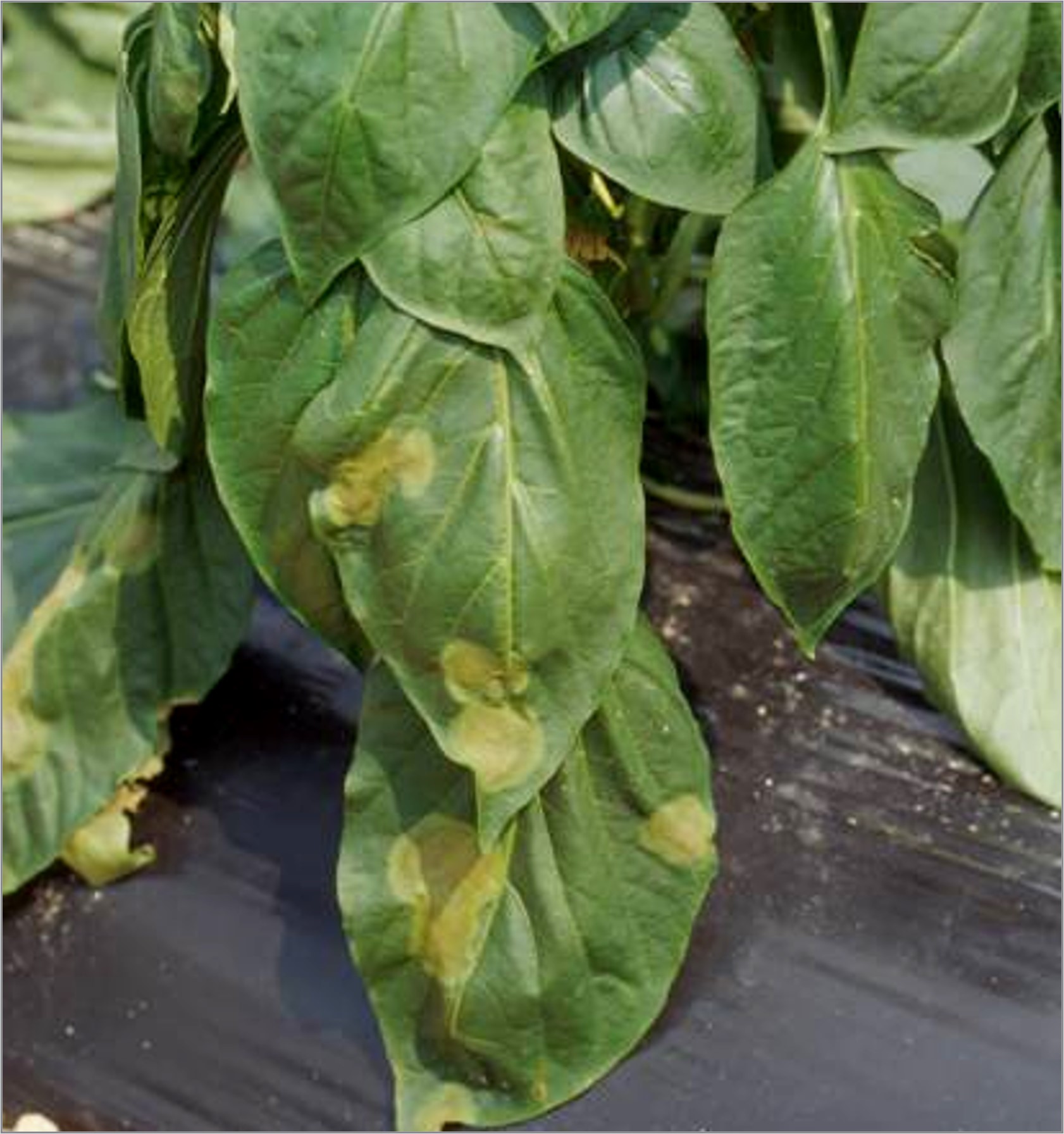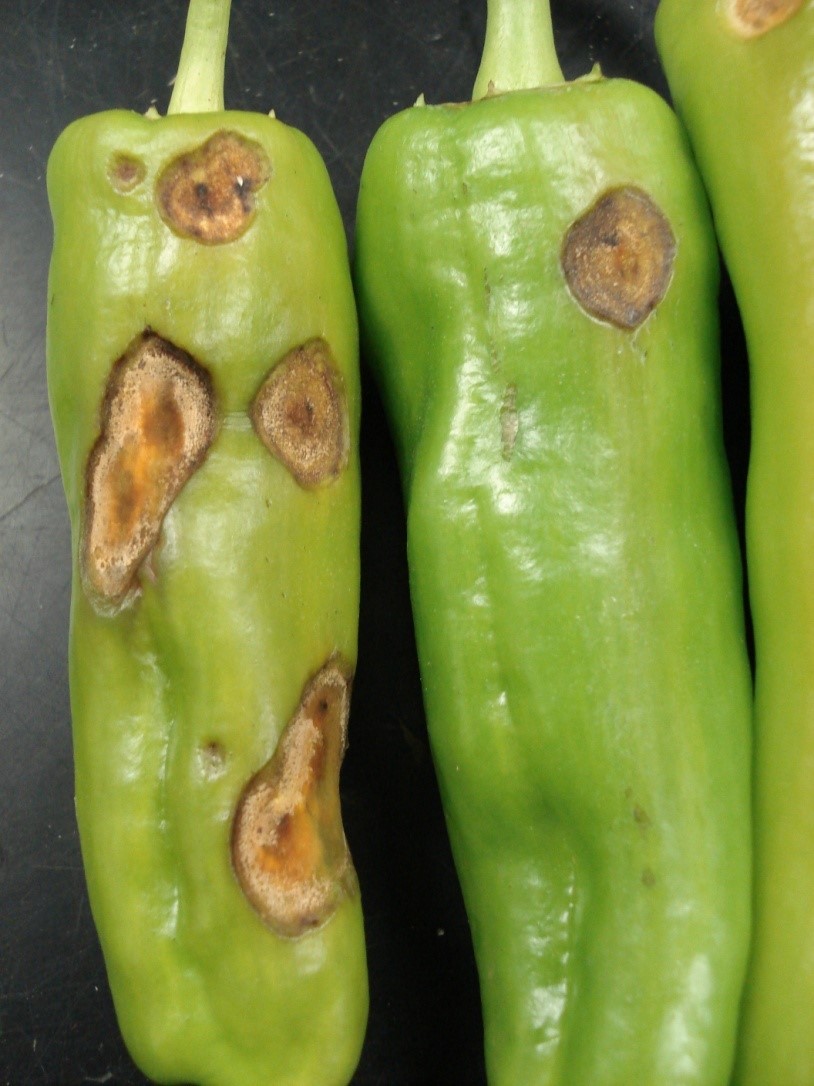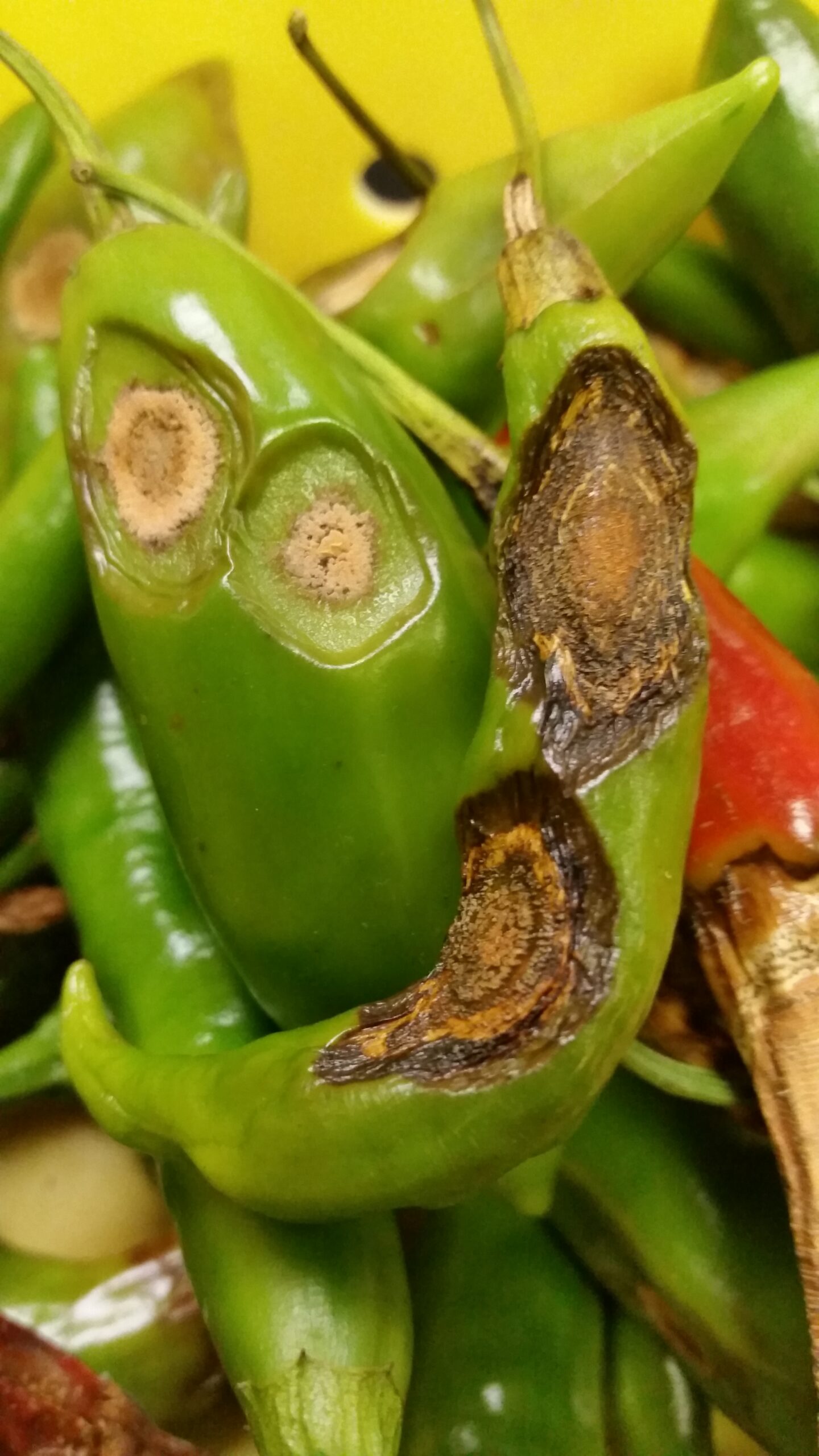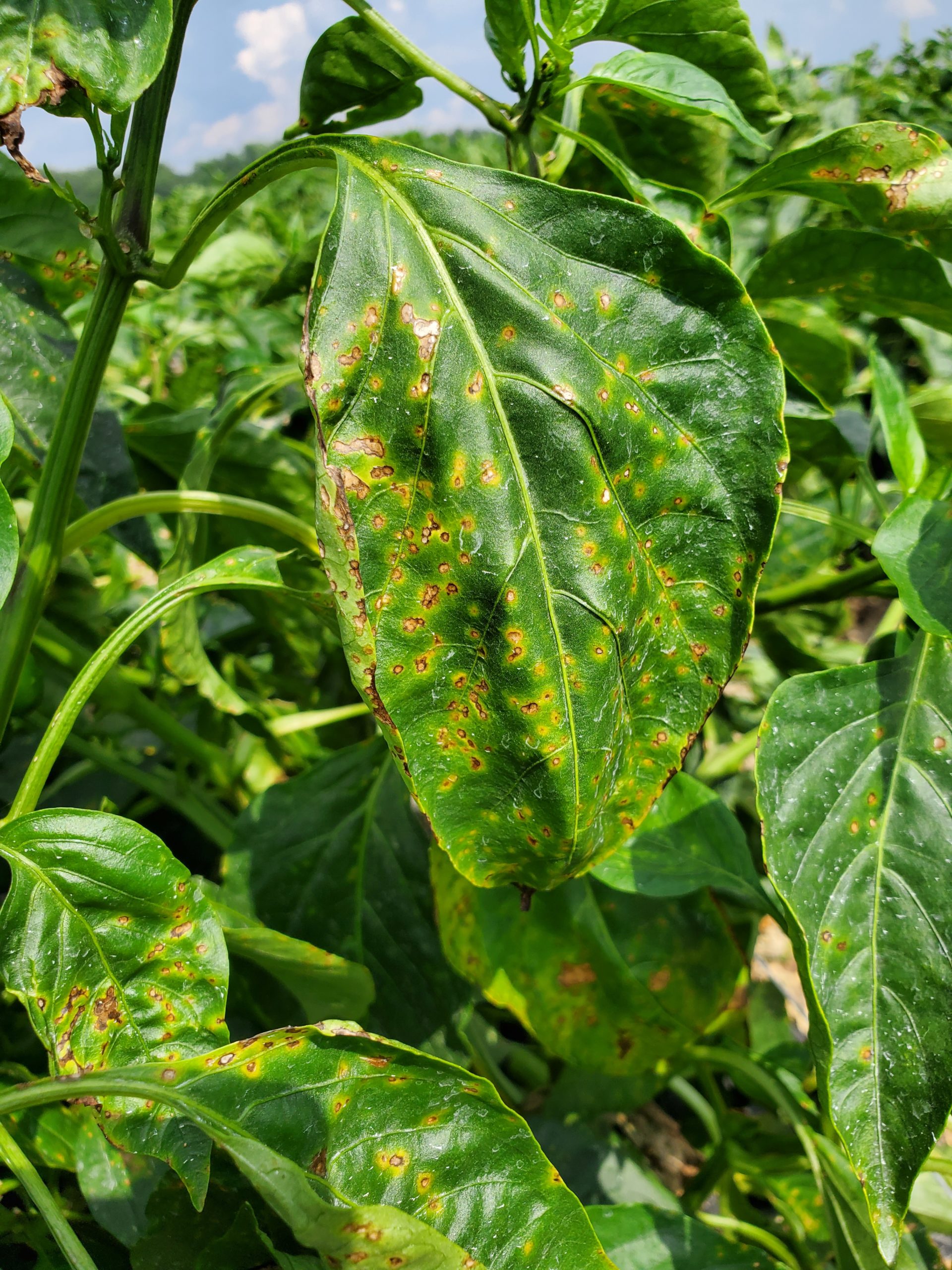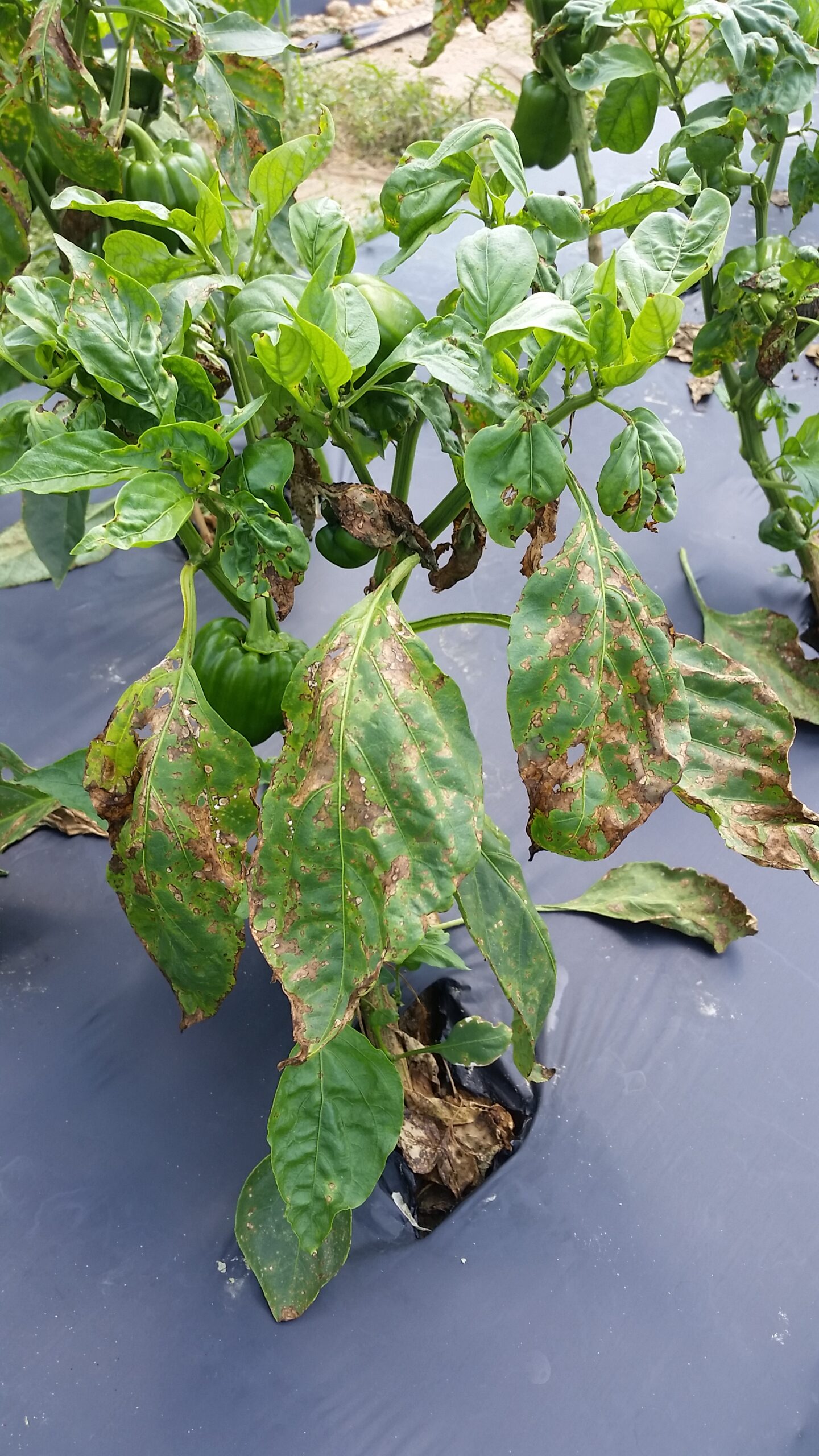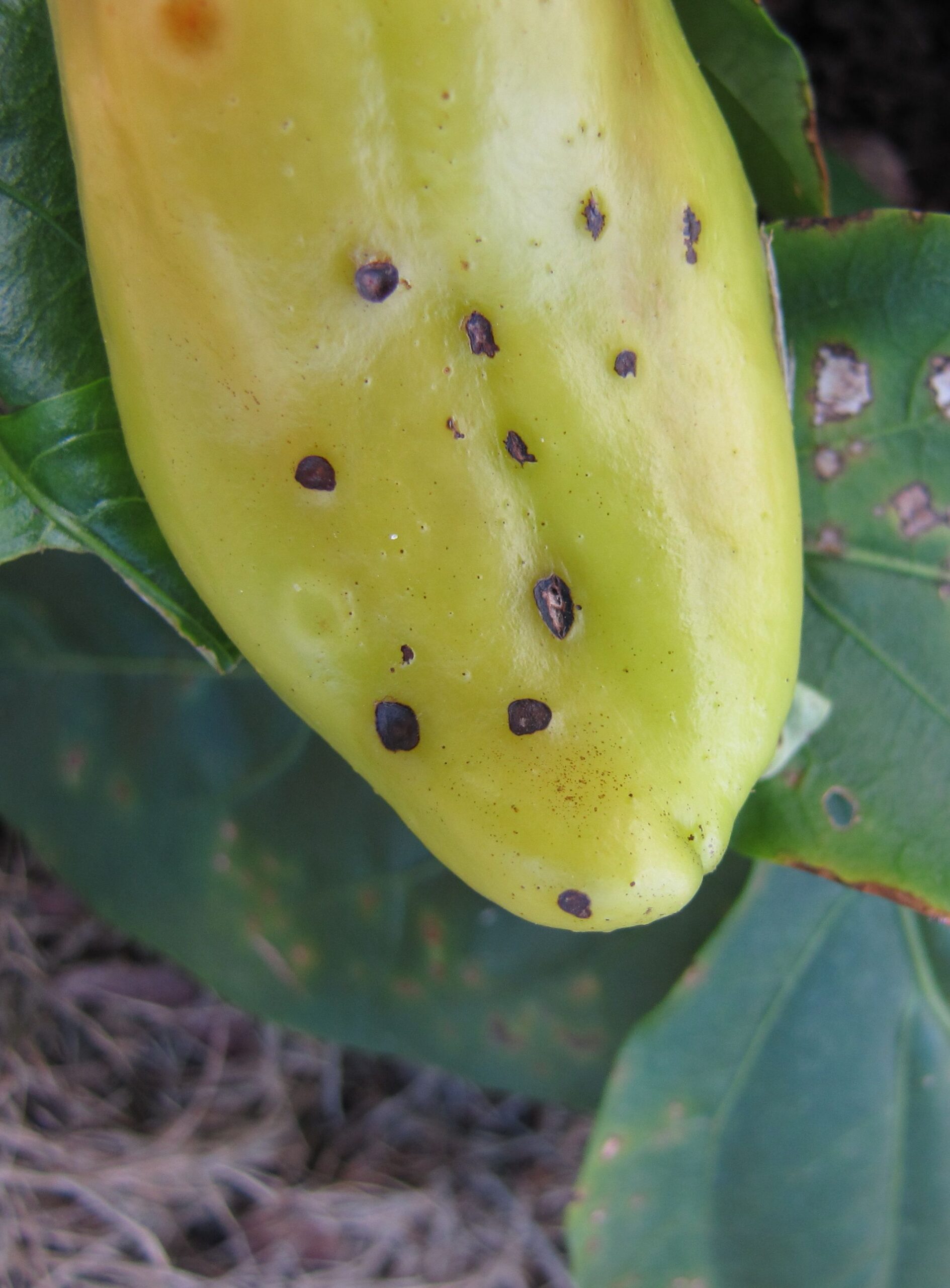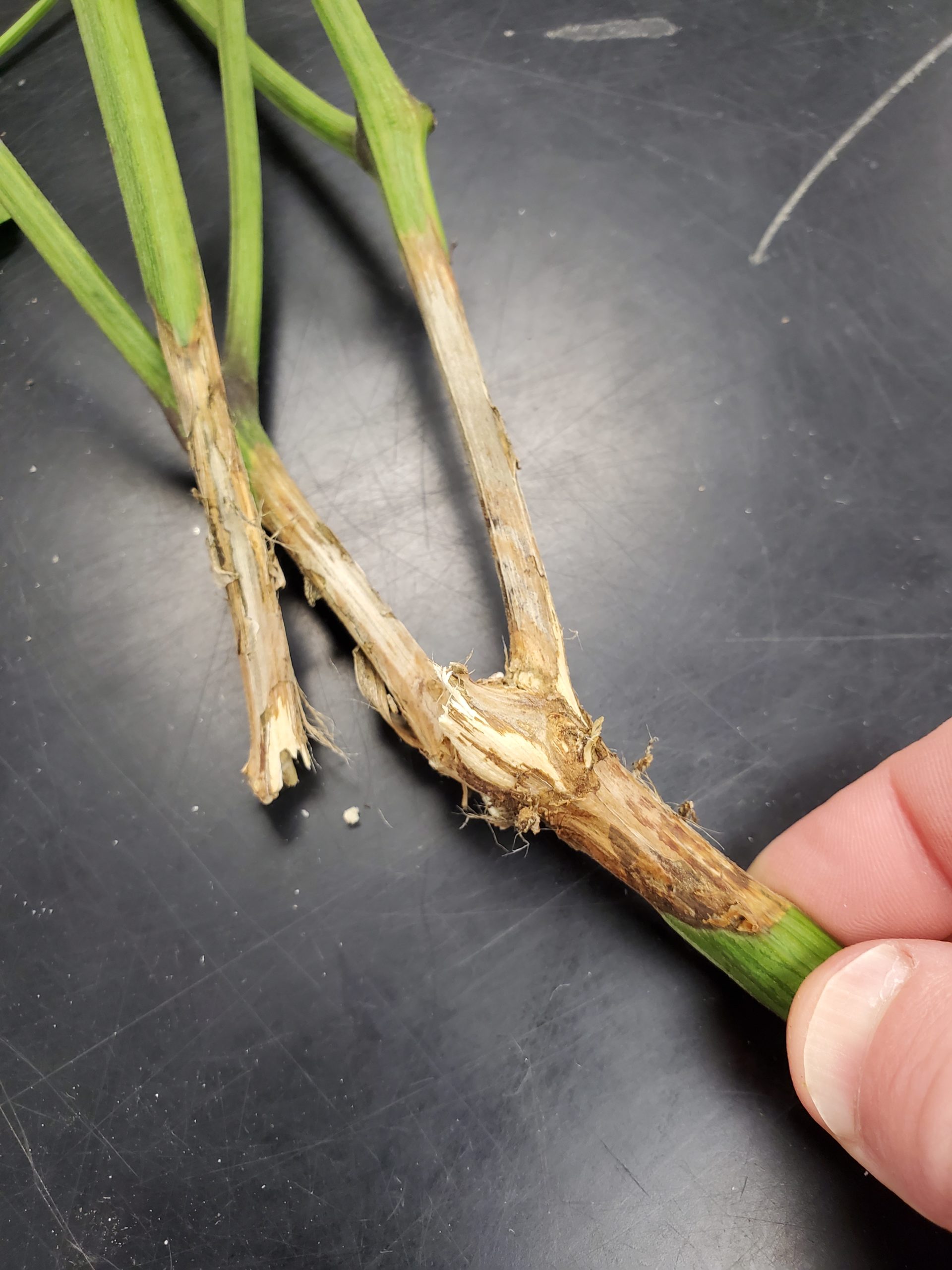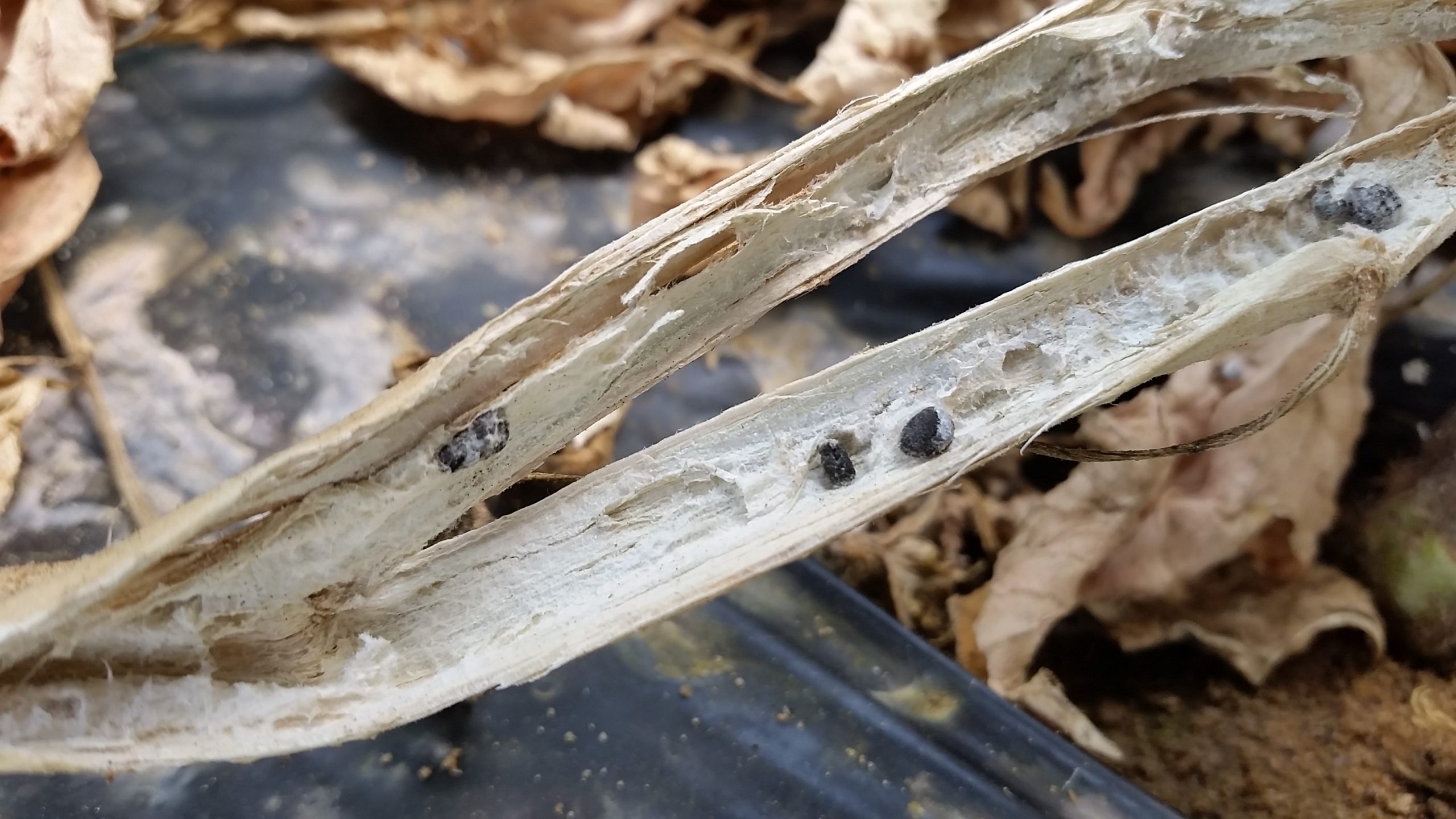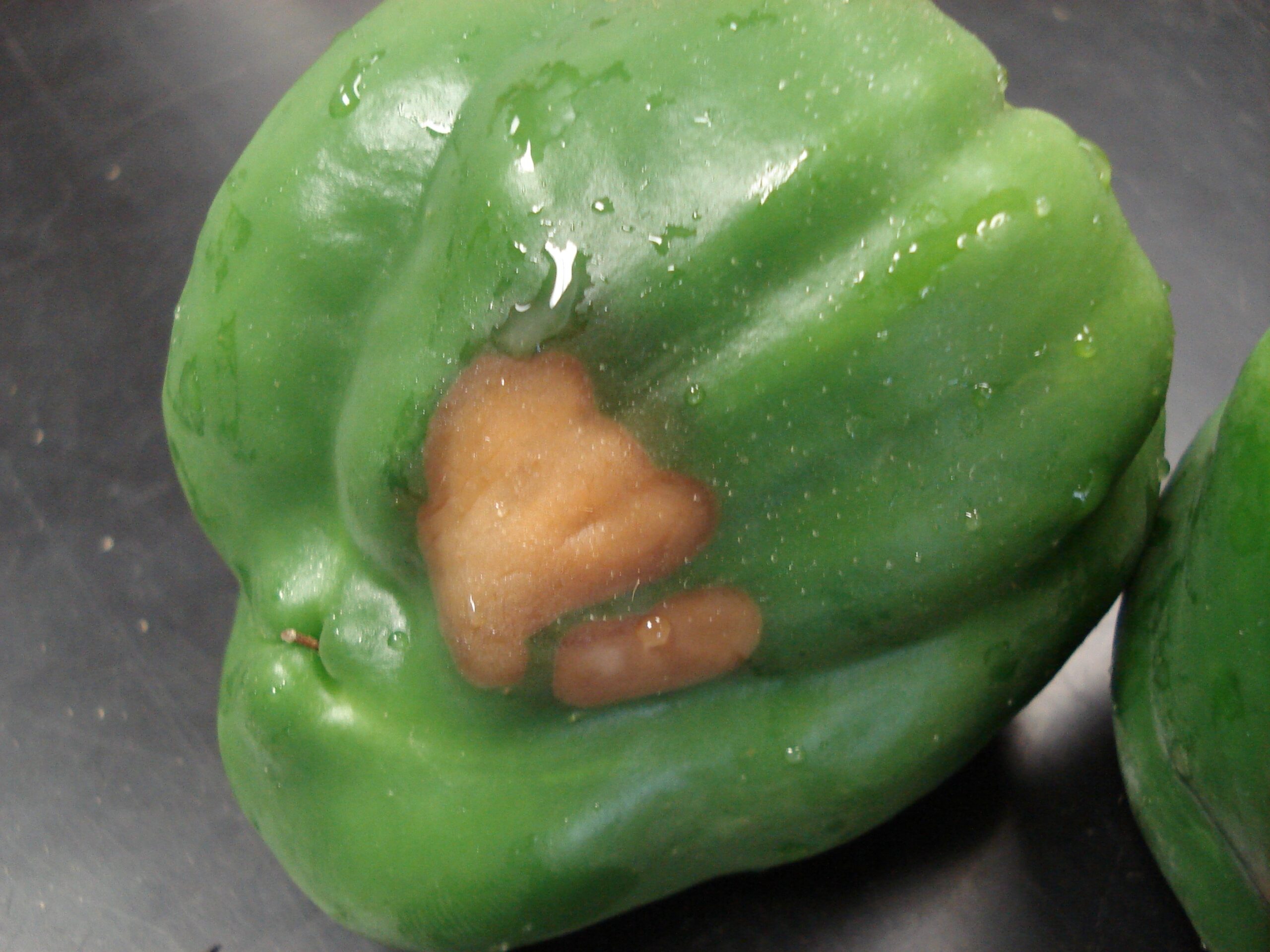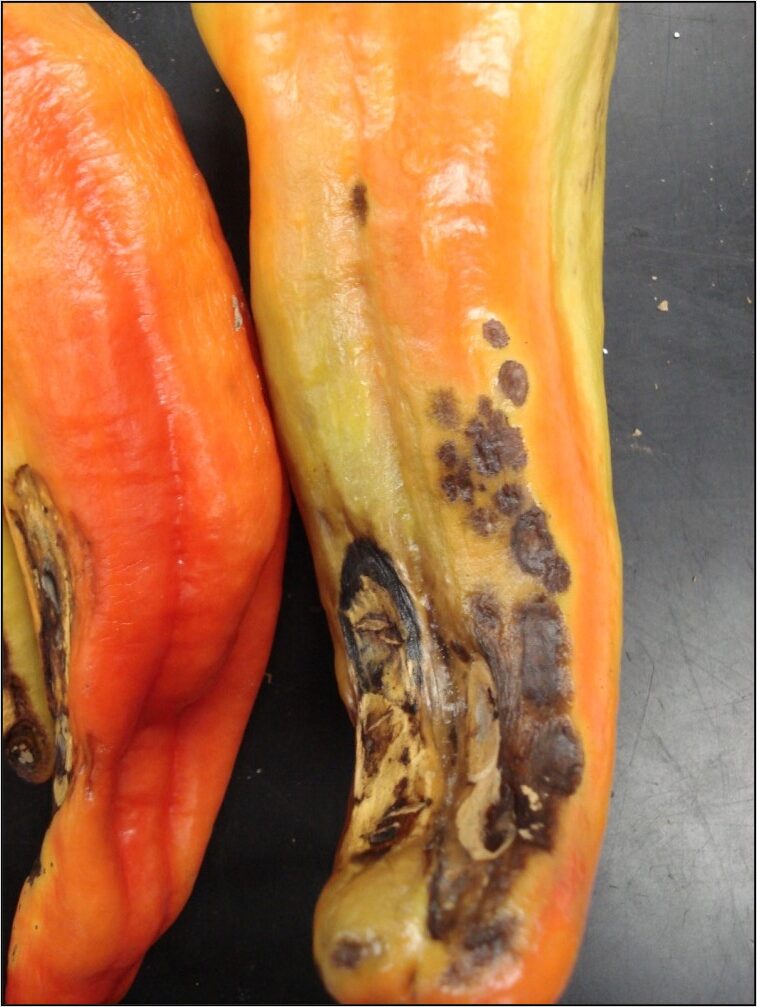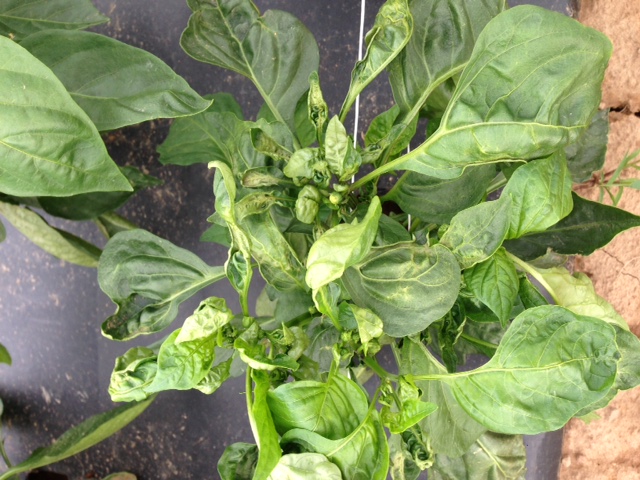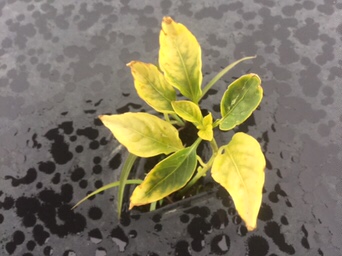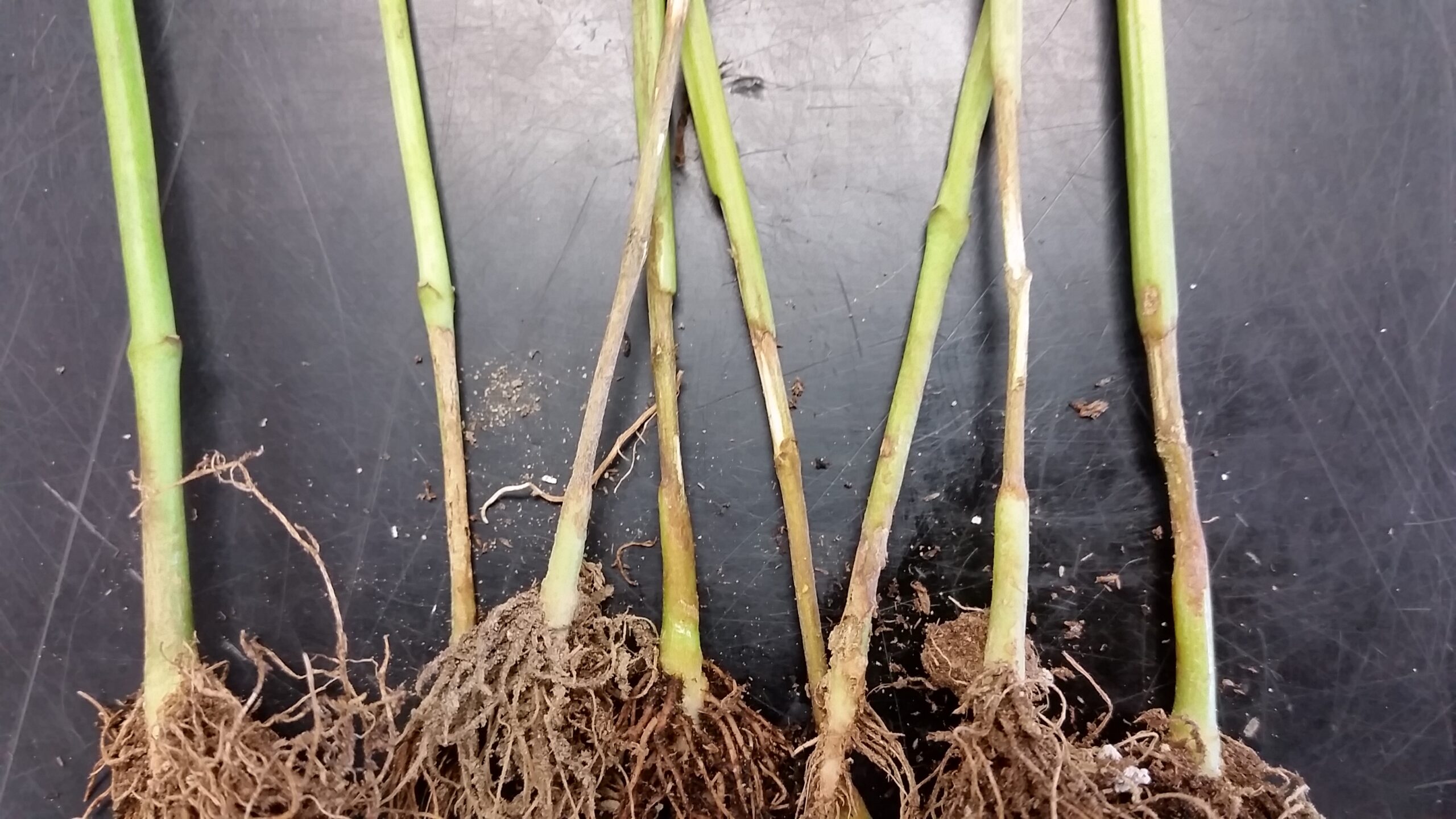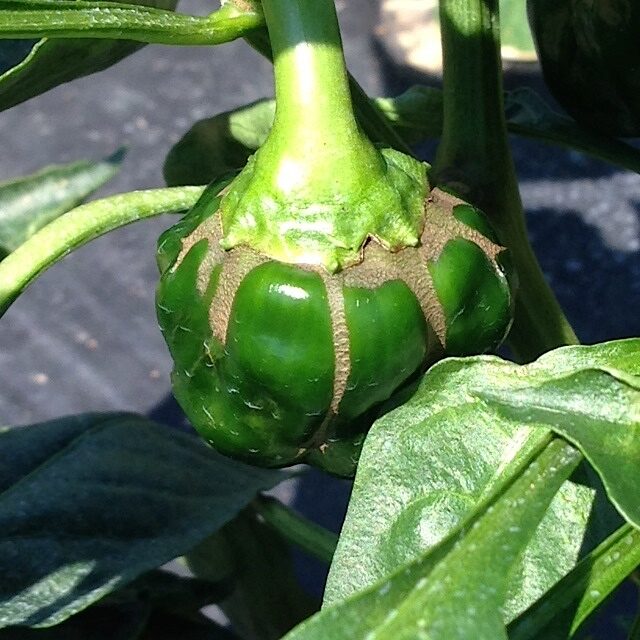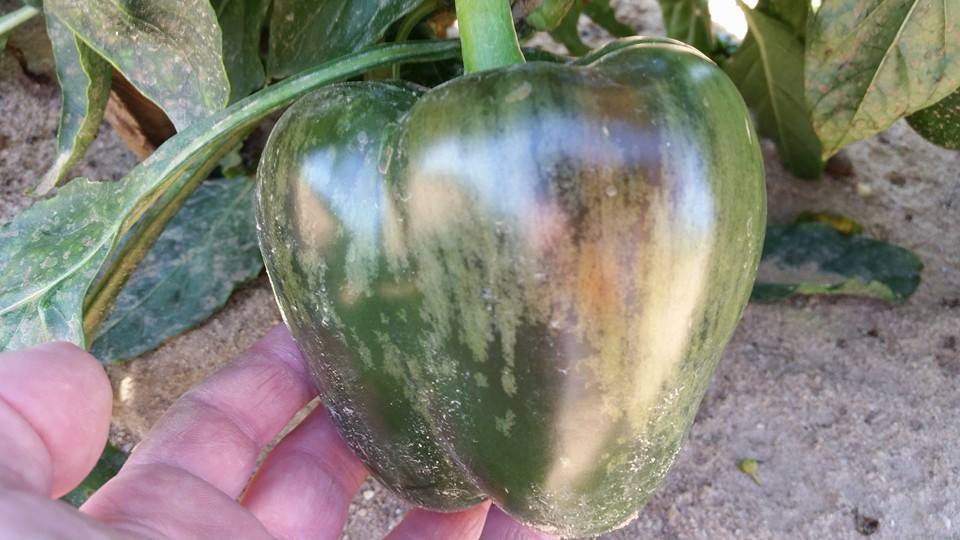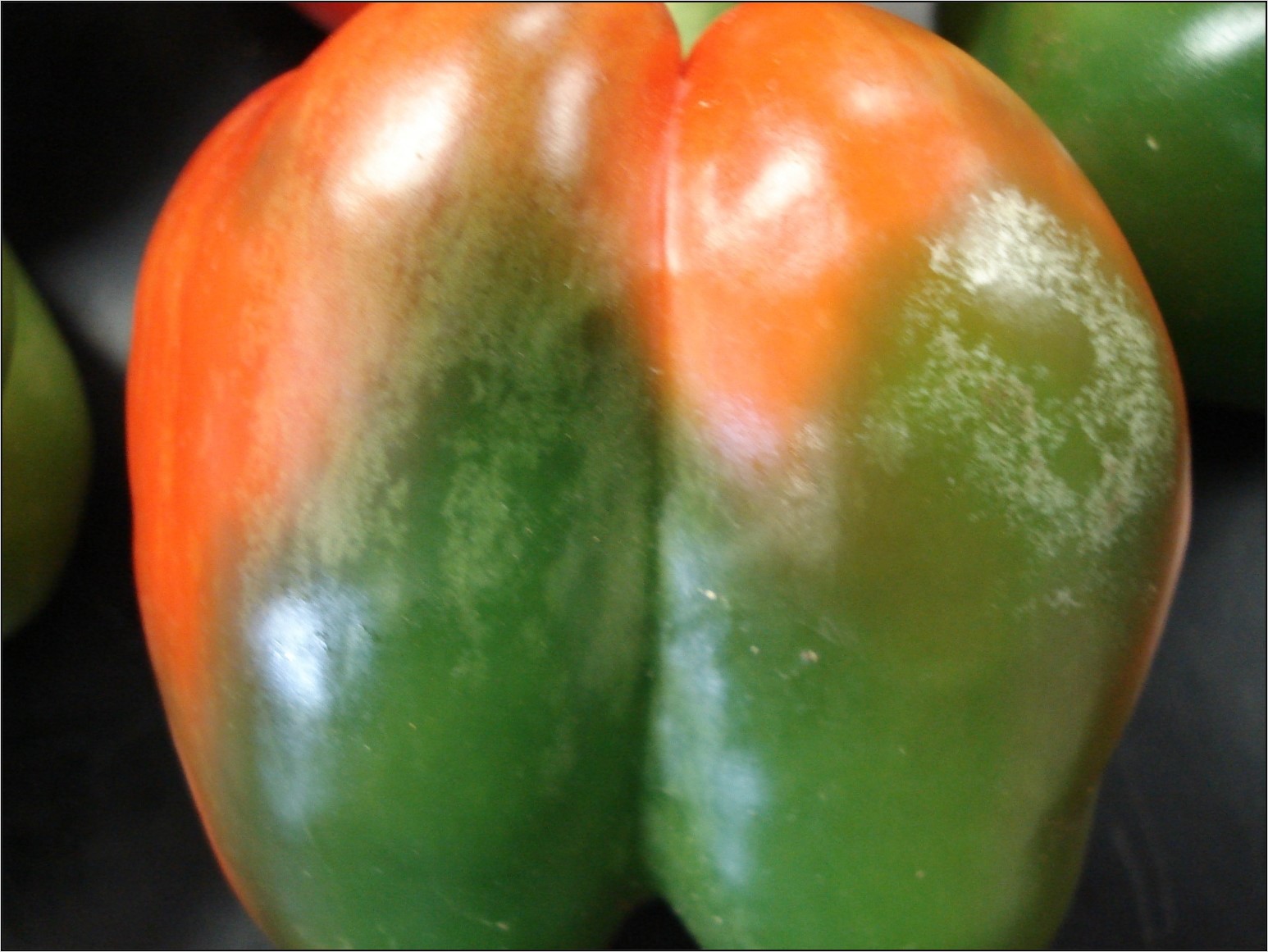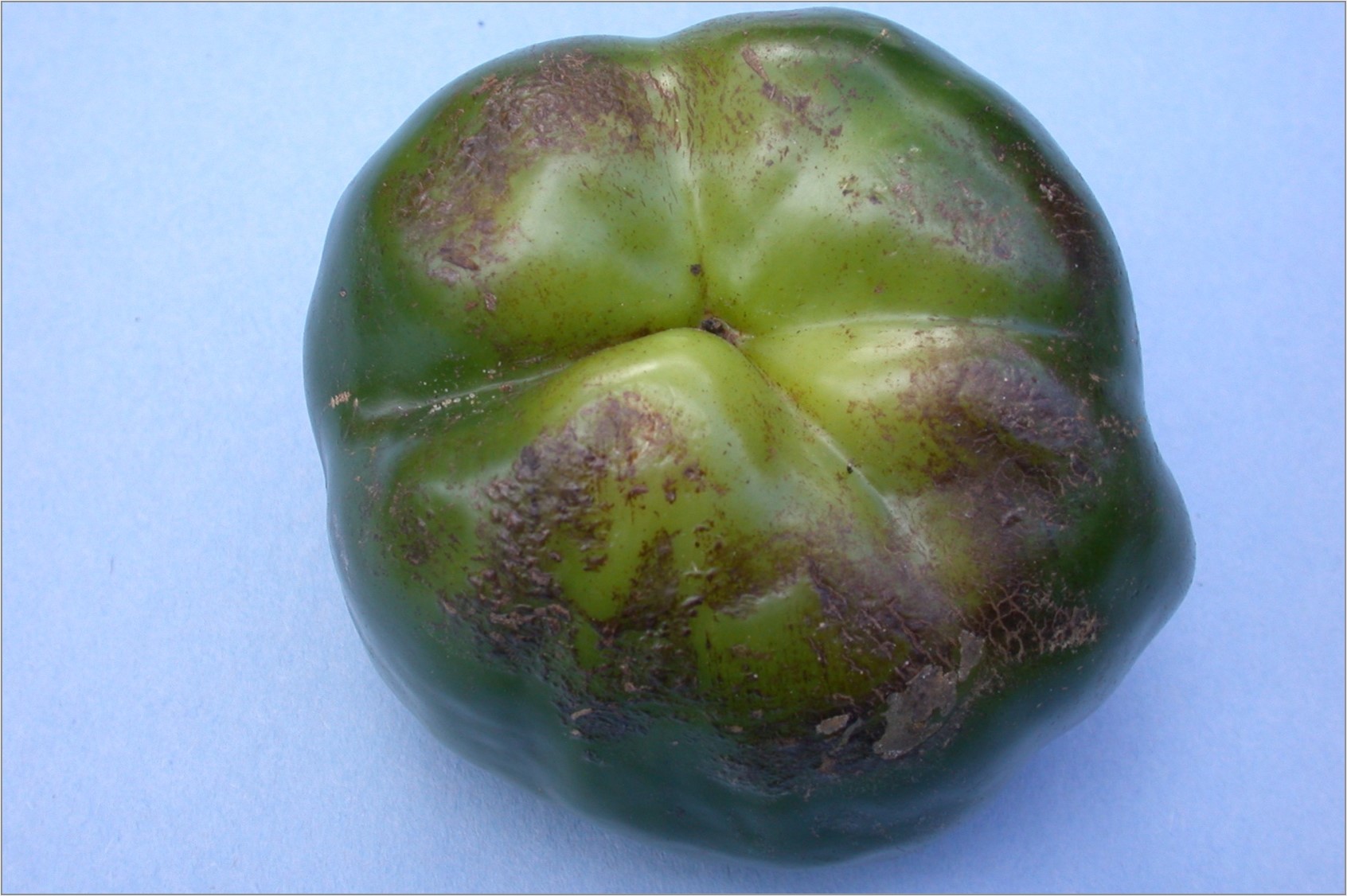Symptoms usually begin to appear on random plants throughout the field as green fruit begins to mature. The bacterium (Pseudomonas corrugata) is ubiquitous to soils and develops when weather conditions (cooler nights/very hot, humid days) and cultural practices (i.e., excess heavy N use) lead to favorable conditions for disease development. Symptoms include the development of irregular greasy (at first), brown lesions on main stems and branches. Late pruning (i.e., suckering) can provide entry points for the bacterial disease. Internally, stems will become chocolate brown and mushy. High humidity is necessary for disease development. High nitrogen and lower night temperatures are associated with Pith Necrosis development, where it has been reported around the state this past week. Control begins with cultural practices such as avoiding working in fields with wet foliage, avoiding late pruning, tying when plants are wet, and watching the amount of N applied to plantings. Infected plants can be rouged from field and most often it does not spread to nearby uninfected plants.
Diagnosing Important Diseases In Tomato – Reference Guide
The following images consist of important diseases in tomato. These images can be used as a quick reference for diagnosing important fungal and bacterial pathogens. For best results, please turn your device (i.e., cell phone) sideways. For information on commercial control recommendations, please visit the tomato section of the 2022/2023 Mid-Atlantic Commercial Vegetable Production Guide. Additional information for home gardeners is located at the bottom of the Table.
For the homeowner or non-commercial grower there are a number of Rutgers/NJAES Fact Sheets available on-line:
For other Rutgers University/NJAES Fact Sheets for tomato please click here.
Diagnosing important diseases in Pepper – Reference Guide
Andy Wyenandt, Wesley Kline, and Kris Holmstrom
Avoiding Plectosporium blight in cucurbit fields
Plectosporium blight, also known as Microdochium blight or White speck, caused significant problems in some pumpkin fields the last few summers in New Jersey. The soil-borne fungal pathogen, although somewhat uncommon, can unexpectedly show up in some years and cause significant losses if left uncontrolled. The fungus survives in the soil on decaying plant debris where it can remain saprophytic by surviving off organic matter. Infection is characterized by the production of numerous light tan to “bleached” spindle shaped lesions that develop on vines and the undersides of infected leaves. Heavily infected vines and leaves can die leading to premature defoliation and subsequent sunscald on fruit. In cases of heavy disease pressure, spores that are produced on the bottom sides of leaves fall and infect the topsides of fruit laying beneath the canopy. Infection of stems leads to premature browning and drying reduce their longevity. Fruit infection, in most cases, remain mostly cosmetic in nature reducing fruit quality and may predispose fruit to other opportunistic fruit rots. Plectosporium blight often shows up during periods of prolonged wet weather where the soil remains wet for extended periods. “Hot spots” typically appear in fields before the pathogen is further spread by driving rains and wind.
From a production standpoint, stay away from fields with known history of the disease for as long as possible; provide adequate spacing between plants in- and between rows (i.e., avoid the overcrowding of plants); avoid over (pre-plant) fertilization that can lead to thick, dense canopies; avoid overhead irrigation (if possible); avoid planting in area of a field that remains heavily shaded where soils tend to dry too slow.
Controlling Plectosporium blight begins with regular scouting, recognizing symptoms, and identifying “hot spots” in the field. Protectant fungicides, such as chlorothalonil, as well as those used in weekly maintenance spray programs for cucurbit powdery mildew control will help control Plectosporium blight as long they applied on a weekly schedule with a high volume of water with thorough coverage. To help improve control on the undersides of leaves, a FRAC code 11 fungicide such as Quadris Top or Pristine, can be added to the tank mix. Remember, FRAC code 11 fungicides have translaminar activity and will move from the top surface of the leaf to the bottom. Growers who grow powdery mildew resistant varieties need to remember to scout their fields regularly even if cucurbit powdery mildew has not been detected on the farm or if regular maintenance sprays haven’t begun.
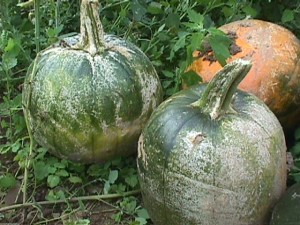
White speck lesions covering the surface of immature and mature pumpkin fruit. White speck will only cause cosmetic injury to fruit.
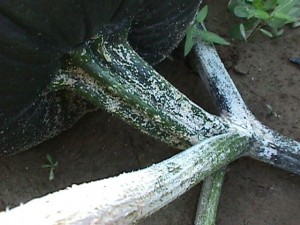
White speck on vine and stem of infected pumpkin plant. Note the numerous small, white diamond shaped lesions.
Recognizing Angular Leaf Spot in Cucurbits
Angular leaf spot, caused by the bacterium (Pseudomonas syringae pv. lachrymans), is common in New Jersey and the region. Although it often shows up during cooler, wet weather; it can show up almost anytime during the production season with favorable weather conditions for its development.
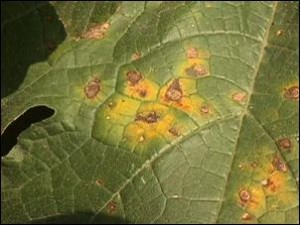
Symptoms of angular leaf spot in cucurbit.
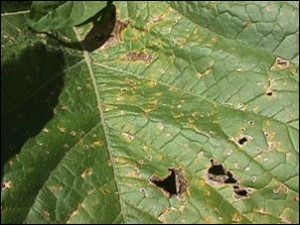
Angular leaf spot of pumpkin. Note leaf ‘shot holes’.
Angular leaf spot will first appear in ‘hot spots’ as, small water-soaked lesions which will expand until they reach a larger leaf vein resulting in the angular looking symptoms on leaves. Under heavy disease pressure, the bacteria will infect fruit causing small, water-soaked circular spots. In many cases once weather conditions become dry again, infected tissue in leaves will die and fall out leaving the characteristic ‘shot hole’ symptoms. Control of angular leaf spot begins scouting your fields, particularly in areas that may get shaded and remain wet after heavy rainfalls. Application of labeled rates of fixed copper plus mancozeb to help suppress the spread of the disease until hot, dry weather returns.
Important fungal diseases in Asparagus during the summer months
Asparagus growers should consider scouting their fields regularly during the summer months for foliar disease development. Important pathogens that growers need to scout for on a regular basis include Purple spot, Cercospora, and Rust. [Read more…]
